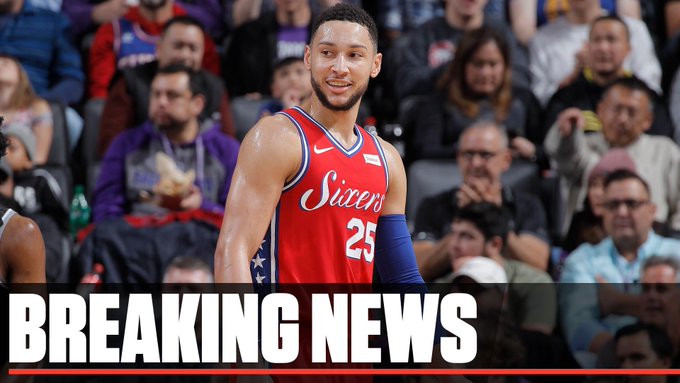
Getty Ben Simmons (left) and Jimmy Butler, as Sixers teammates
Three years ago, the Sixers strolled into an exceptional situation. The Timberwolves, having shrugged off the unhappiness of star guard Jimmy Butler for the entire summer, had gotten desperate. After a tumultuous training camp in which Butler mostly sat out, except to come in and embarrass young teammates by loudly dominating them in a scrimmage before doing an ESPN interview, Butler appeared in 10 games before Minnesota finally had to wave a white flag and get Butler out of town.
The Sixers took advantage, acquiring Butler. Philadelphia gave up Robert Covington, Dario Saric and Jerryd Bayless for Butler, who had been an All-Star for four straight years. It was an extraordinarily scant price to pay for the Sixers, but that is what happens when teams look to trade star players from a position of desperation.
Now, the tables are turned on Philly, as the Ben Simmons saga careens toward some conclusion that likely isn’t favorable to the Sixers. Simmons has reportedly vowed to “never” play for the Sixers again, but with training camp set to start next week, Simmons remains on the roster.
“It is a lot like the Jimmy Butler in reverse for them,” one general manager told Heavy.com. “I think for the Sixers, they have been hoping to get fair value for Ben all along, so they want Damian Lillard or they want all of Golden State’s young guys. That is what you hope for. But for the rest of us, we’re looking at it and we want to give you Covington and Saric, we want the Jimmy Butler bargain. It’s not exactly the same thing, but it is that dynamic, the rest of the league can just wait until they have no choice.”
Butler Was in the Final Year of His Contract
Indeed, the big difference between the Simmons and Butler situations is the contracts. Butler was in his final year with Minnesota and had rejected an extension—he did not want to play with young Wolves Andrew Wiggins and Karl-Anthony Towns going forward. Because he was going to hit free agency in the summer of 2019, Butler held a lot of leverage in his situation with the Timberwolves.
That increased the desperation the Wolves had to move him and the trepidation teams had in making a deal for Butler, because there was a chance the team would trade for Butler and he would then leave after the season.
That left the Timberwolves with very little power and, thus, the Covington-Saric-Bayless package.
Simmons is different, in the second year of a five-year, $170 million max extension he signed with Philadelphia in 2019. He still has $140 million on his contract and thus has much less leverage in picking where he wants to play. That’s why the Sixers are trying the patience route here. If the Sixers do nothing, Simmons might miss training camp and could even hold out into the season.
But he won’t get paid if he does that and there’s no way he will hold out an entire season, let alone the next four years. The Sixers hold some advantage because of that.
“Philadelphia has more power here, the Timberwolves had no power with Butler,” the GM said. “No doubt about it. But the end result is the same, right? If the guy is telling you the relationship is broken beyond repair, you’ve got to take that seriously. He is telling you, ‘We’re not going to fix this, I don’t want to fix this.’ So your options are limited.”
Did the Timberwolves Pass on Better Offers for Butler?
It is informative to look back on how the Timberwolves handled trade negotiations for Butler three years ago, because there could be some cautionary tales for the Sixers.
First, the Wolves front office, which consisted of Tom Thibodeau and Scott Layden at the time, refused to even accept calls on Butler trades all summer, despite Butler’s expressed desire for a trade. It wasn’t until owner Glen Taylor stepped in during training camp that the Wolves began looking for a deal in earnest.
The Sixers, wisely, have been willing to take Simmons offers all summer. But the asking price has been so high that some wonder whether they’ve been serious about making a deal.
In October 2018, during training camp, the Wolves thought they had a deal with the Heat in a package centered on Josh Richardson, who was then 25 years old and had not gone into the three-year shooting slide that has marked his career recently. Butler later claimed Bam Adebayo was also part of the deal, though other reports had it as a future first-rounder and with the Heat firmly rejecting Adebayo’s inclusion.
But Minnesota pushed for more in the deal and the Heat walked away. When the Wolves tried to revive the deal after the season started, Miami said Richardson was no longer available—he had averaged 21.4 points in the Heat’s first nine games, and the Heat wanted to keep him.
The Timberwolves had tried to get the Wizards involved for Butler, looking to pry away Bradley Beal. They did the same with New Orleans, looking to extract Jrue Holiday. Neither Washington nor the Pelicans would bite, though.
New Orleans did make a counter offer, according to The Athletic: Nikola Mirotic and a first-round pick. There was also an offer from the Rockets of Eric Gordon and two first-rounders. With scant options, and with Thibodeau also serving as the team’s coach and unwilling to take Minnesota back into a rebuilding phase, the Wolves took the Sixers’ offer of Covington, Saric and Bayless.
That was a mistake in hindsight. The Wolves would have been better off with a draft pick, even if only to trade it later.
The Sixers are in a similar position, looking to win in the present, during Joel Embiid’s prime years. But they can look at the Jimmy Butler situation—even with its differences—and perhaps draw some lessons.
